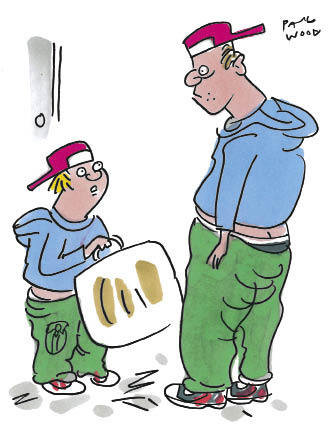Martin Vander Weyer’s Any Other Business
I’m standing on a hot platform at Tottenham Court Road, waiting for the relief of the momentary breeze that precedes an approaching train. I’m staring at a T-Mobile poster featuring people dressed as nuns at what looks like a karaoke party. And I’m thinking: do I really want to write another essay about the imagined pain of cuts to come, or the right way to regulate banks, or the prospects for growth in 2013-14? And more important, in a heat wave and a mood of post-World Cup gloom, do you really want to read one? Then the air moves, the train rattles in, and I see that it’s bound for the High Barnet terminus of the Northern Line. And the mission of Any Other Business for this week comes to me: I must find the Stone Parlour.
This will take a bit of explaining, but bear with me: I hope you’ll think it’s worthwhile. Every family has a private vocabulary, and in mine a ‘Stone Parlour’ is a place of enforced contemplation. Thus if my dog Douglas misbehaves when we visit my mother — chases her cat up the stairs, for example — he is ordered into the Stone Parlour, which means he is shut in the porch until his hangdog expression suggests that he’s ready to repent of his sins.
The original Stone Parlour was a bare cell reserved for precisely the same purpose at St Martha’s Convent Junior School in Barnet, which I attended half a century ago, between the ages of four and six. It had a crucifix on the wall, perhaps a single wooden chair, and a window from which the solitary miscreant could see in the distance the playground from which he had been banished.
Being a relatively diligent little chap, I was only occasionally incarcerated. But my very naughty friend Bernard — who these days would have been diagnosed with a whole set of behavioural syndromes and dosed to the eyeballs on Ritalin, but who I like to imagine eventually made good as a Mercedes dealer on the North Circular, or perhaps a developer of buy-to-let flats — seemed to spend half his school life in there. I have a memory of his pale face at the window. I worried about him a lot.
And because we had been talking about it at home recently, and I had never set foot in Barnet since we moved away in 1961, I conceived a sudden urge to find out whether the real Stone Parlour still exists. So instead of alighting at Euston, I stayed on the train all the way through leafy Finchley, Totteridge and Whetstone to the end of the line.
When we lived there, in a flat above Barclays Bank on the High Street, Barnet was a proud little Hertfordshire town. Since 1965, its name has been attached to an outer London borough, its distinctive character blurred into a suburban sprawl from Edgware to Golders Green. But a stroll uphill past the parish church of St John the Baptist provides plenty of reminders of the town’s history.
This was the Great North Road, a day’s ride and a steepish climb from the centre of London. It was also a very important livestock market, where beasts were bought and sold before their final southward journey to city slaughterhouses. So it was a place where travellers paused; hence Dickens’s observation, in Oliver Twist, that ‘every other house in Barnet was a tavern, large or small’. Many are still there: the Olde Mitre, built in 1633; the imposing Victorian Red Lion, now sadly rebranded a ‘Toby Carvery’; but not the Star, the ancient coaching inn in whose garage my father kept the absurdly magnificent 1932 Buick he bought on a whim. That one is long gone, replaced by a mini- supermarket.
Many other old premises along my walk had found modern purposes: I counted half a dozen charity shops, almost as many opticians, and several cheerful nail salons and ‘smoothie bars’. But the Dutch-gabled Edwardian Post Office has yet to be turned into anything else; and the Barclays branch, a reassuringly dignified pre-war building, is still there and busy enough for me to slip un-noticed up the back stairs, where a sign said ‘Local Business’ — though no one seemed to be doing any — to the locked door of the flat, now empty offices. Through a porthole I could see the corridor where Bernard and I once made a pirate ship out of a folding table.
So on I went in search of the Stone Parlour: encouragingly, St Martha’s Junior School was still shown on the town map. I walked back past the church into historic Wood Street — diverting briefly into the park where, in Red Indian costume and war paint, I once won a prize in a road-safety-themed fancy dress competition, wearing a card round my neck saying ‘I’d rather be hit by a tomahawk than a Humber Hawk’. How my father was proud of that line.
And here at last, set back in a garden, was the convent and school built in 1914 for the French order of Sisters of St Martha. ‘Couvent St Marthe Montmartre’ says the stone frontage — but the statue of the Virgin has gone from the garden, and I’m a year too late. The gates are chained, and an estate agent’s sign proclaims ‘St Martha’s Court’, a development of luxury one- and two-bedroomed apartments ‘suitable for investment’, about to go on sale this very weekend. The school closed last summer, I discover, victim of a decreasing pupil roll and the adverse economic climate.
But I wasn’t giving up. I went round the back into Union Street and found an open gate into the schoolyard, which must have been sold separately and is yet to be redeveloped. The classroom where Sister Mary Joseph filled my five-year-old head with the theology of limbo and purgatory had been rebuilt, but otherwise the place was just as I remembered, except for a stout new fence separating it from the old convent.
Peering over the top, I picked out what I thought was the window of the Stone Parlour, now perhaps the designer kitchen of one of those desirable apartments. No Bernard peered back — but who knows, perhaps he’s the developer of St Martha’s Court. That would certainly be a neat form of revenge.
Ah well, I’m glad I made the journey. As I wrote here about the banking crisis, institutions and places that seemed so permanent in our earlier lives rarely prove to be so, but very often find interesting new destinies. Normal service will resume next week, when I shall no doubt nominate some City sinners for a spell in my imaginary Stone Parlour.







Comments